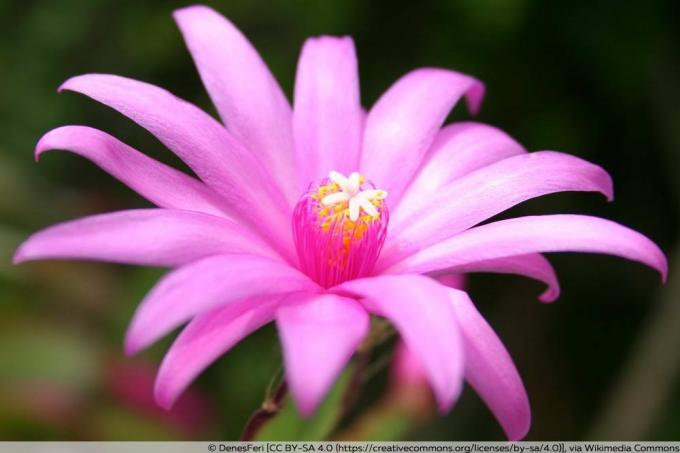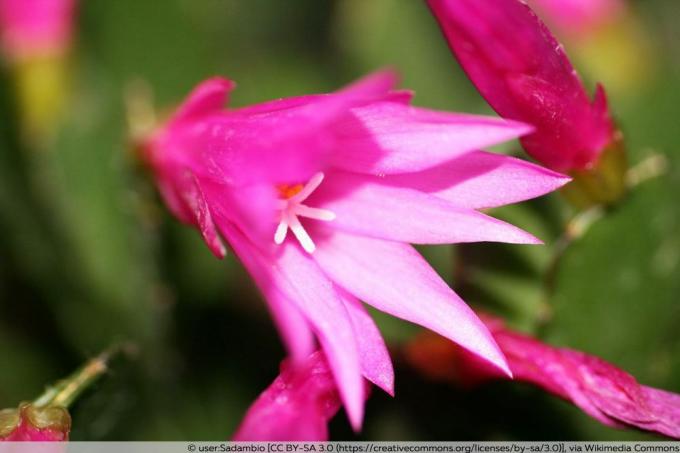
table of contents
- Characteristics
- Location
- blossom
- Substrate
- care
- to water
- Fertilize
- Cut
- Repot
- Overwinter
- Multiply
- Diseases and pests
Profile and care information open +conclude -
- Flower color
- orange, pink, red, white
- Location
- Partial shade, no sun
- Heyday
- March, April, May, June
- Growth habit
- bushy, overhanging
- height
- up to 40 cm high
- Soil type
- sandy, clayey
- Soil moisture
- moderately dry, fresh
- PH value
- weakly acidic
- Limescale tolerance
- Calcium intolerant
- humus
- k. A.
- Poisonous
- no
- Plant families
- Cactus family, Cactaceae
- Plant species
- Potted plants, ornamental plants
- Garden style
- Pot garden, ornamental garden
The Easter cactus, also known as the spring cactus, is often described as an easy-care diva. This is because it is easy to care for, but has special demands when it comes to flowering. Because if its conditions are not met, it refuses to flower or, quite diva-like, simply throws off buds and flowers. However, if it is satisfied with its location and care, it will thank you every year with a new splendor of flowers.
Characteristics
- botanical name: Hatiora x graeseri (Schlumbergera x graseri)
- Plant family: Cactus family (Cactaceae)
- Habit: slightly overhanging, 30 to 40 centimeters in height and width
- Flowers: all shades of orange and red, white, pink; bell-shaped
- Flowering period: March to June
- Leaf color: green
- pH value: slightly acidic
- Use: ornamental plant
- non-toxic
- sensitive to lime
Location

The Easter cactus (Hatiora x graeseri) belongs botanically to the plant genus Hatiora from the family of Cactus family (Cactaceae), because it is a hybrid of the species Hatiora gaertneri and Hatiora rosea. Nevertheless, the limb cactus is not a sun worshiper like its relatives, but reacts extremely sensitively to the blazing sun, as well as drafts. Therefore, the ideal location for the Easter cactus has the following properties:
- bright (evening or morning sun)
- warm (16 to 24 degrees in the growth phase from flowering to October)
Since the Easter cactus likes to spread, you should provide enough space for it. If the limb cactus is on a window sill, there should be some space between the plant and the window pane. In this way, the sun's rays are weakened even more. During or shortly before flowering, the cactus must not be moved at all, because even the smallest changes, such as for Slightly moving it, for example, can result in only a shortened bloom or the bloom in its entirety fails. The temperature also affects the flowering. The ideal temperature for flower formation is between 10 to 15 degrees Celsius.
Tip: If the Easter cactus is placed on a south-facing window, the distance to the window pane should be at least 50 centimeters.
Outdoor season
Hatiora can also spend the summer on the balcony or terrace. A partially shaded spot where it is protected from wind and rain is ideal. The outdoor season ends when temperatures start to drop below ten degrees Celsius. You should also prepare the cactus for the outdoor season. To do this, keep it outside for a few hours so that it can get used to the new surroundings.
blossom

In order for the Easter cactus to develop many flowers, the following conditions should be met:
- water less from October
- Place plants in a location with 10 to 15 degrees Celsius
- Keep light conditions constant during the winter break
After flowering, when the growth phase begins, the cactus is allowed to move to a warmer place. It is difficult to predict whether the Easter cactus will bloom exactly at Easter next year after the hibernation, because the cactus does not know when Easter is. That's why you should just let it bloom when it wants. And with a little luck, the flowering period, which can take up to six weeks, will coincide with Easter.
Note: The individual flowers bloom for about three days. However, since the cactus is ideally constantly developing new flowers, the flowering period can take several weeks.
If the spring cactus refuses to flower, you should check whether the location and care meet its requirements. Then you should care for it according to the new conditions, because it is quite possible that it will bloom again in the next year.
Tip: For specimens that are particularly rotten to bloom, it is recommended to overwinter them close to the 10-degree limit.
Substrate
Hatiora thrives best in loose, permeable cactus soil or a mixture of:
- Potting soil (2 parts)
- Sand (1 part)
- Clay (1 part)
Tip: If you mix the plant substrate yourself, make sure that all parts are mixed well.
Alternatively, you can also cultivate it in peat-free herb or vegetable soil. At the bottom of the pot, it is best to lay a drainage layer made of gravel and / or potsherds so that the irrigation water can drain off well and waterlogging is avoided.
care

It is important that it is given a space that meets its requirements and that it is poured sparingly. For the flowering it is crucial that it gets several weeks of cool winter dormancy. If the first signs of flowers appear, the cactus must remain in its place. If it is moved or even relocated, it throws off the buds and flowers offended. And this behavior has brought in the reputation of a diva.
to water
In terms of watering, the spring cactus behaves like its relatives. Since it stores the water in its leaves, it gets by with small amounts of water. It is poured when the surface of the substrate is slightly dry, because the soil should not dry out completely. As a rule, it is sufficient if you water it once a week with lime-free, lukewarm water. Since it does not tolerate waterlogging, you should remove excess water from the saucer or remove from the planter.
Tip: It is recommended to spray the Easter cactus with lukewarm water once a month. However, it must be wiped dry afterwards, as the water breaking in the rays of the sun can burn the leaves.
Fertilize
You should only fertilize Easter cacti very sparingly. The fertilizer application period is from April to September. It is best to use a special cactus fertilizer. In addition, you should better keep the cactus with fertilizer sticks, which release the nutrients only slowly, than with liquid fertilizer.
Cut
A growth-promoting cut is not necessary for the Easter cactus. Even with large plants, cutting should be the last step. If pruning is unavoidable for reasons of space, it is cut after flowering. Since the limbs of the plants are very delicate, you should use a sharp and clean knife for the cut. You should also avoid bruising.
If the spring cactus shows yellow or withered limbs that indicate too much sun and / or too little If the water closes, it is better to tear them off with your fingers instead of them to cut off.
Repot

When the roots grow out of the drainage hole at the bottom of the planter, the time has come to repot the Easter cactus. The ideal time is early spring. It is important that you also renew the substrate when repotting. You should also be careful with the plant so that it and its roots are not damaged.
Tip: In the first year after repotting, you do not need to fertilize the Easter cactus.
Overwinter
If the Easter cactus is outside during the summer, it must be brought inside when the temperatures start to drop below ten degrees Celsius. But cacti that are kept as house plants should also be given a resting phase. This starts in November and ends in February. At this point, the limb cactus should move to a place with less light. The temperatures in the winter quarters should be between ten and fifteen degrees Celsius, under no circumstances below ten degrees. Care is also withdrawn during the rest phase. This means that there is no need for fertilizer and the amount of water used is also reduced.
Tip: In any case, allow the Easter cactus to hibernate, otherwise it will not bloom in the coming year.
Overall, the winter break should be six to eight weeks. This is the period in which the Easter cactus is kept cool. After that, starting around January / February, he slowly gets used to warmer temperatures again. During the familiarization phase, it is important that the light conditions for the cactus do not change and that the temperature remains well below 20 degrees.
Multiply

The simplest form of propagation is with cuttings, which you can cut in May or June. To obtain a cutting, do the following:
- Cut 10 to 15 centimeters long shoot from the mother plant (one to two links)
- use a clean and sharp knife for cutting
- make a smooth cut (do not squeeze)
- Put the cutting in a container with cactus potting soil
- alternatively put in a mixture of potting soil (2 parts) and sand (1 part)
- place in a bright place without direct sunlight
- water lightly
- Keep the substrate moist, but not wet
- first, new shoots visible after four to six weeks
The second form of propagation is done with seeds that you can get in specialist shops. When propagating with seeds, proceed as follows:
- Place seeds on moist substrate
- Pack a planter with a cover made of transparent plastic (greenhouse effect)
- Keep the substrate slightly moist
- first seedlings visible after three weeks
- Removal of the hood at a size of two to three centimeters
- Care for offspring like adult Easter cacti
Diseases and pests
The Easter cactus mostly gets diseases through incorrect care. The greatest danger for the cacti is wet feet, the so-called. Cause root rot. It occurs when the plants are watered too much, or when excess water is not removed or removed. can run off (waterlogging). If the watering is not reduced in time, there is usually no hope for the plants. A recommended rescue measure is to immediately repot the plants in a dry substrate and remove the infected roots. If the irrigation water is too hard, it affects the growth of the cacti. So they stop growing, and the shoot begins to shrink.
In dry indoor air, Easter cacti are often attacked by aphids, scale insects and spider mites. You can prevent these pests by ensuring sufficient humidity or by spraying the cactus with lime-free water at least once a month. Another preventive measure is the choice of location. So you should avoid locations with dry heating air.



